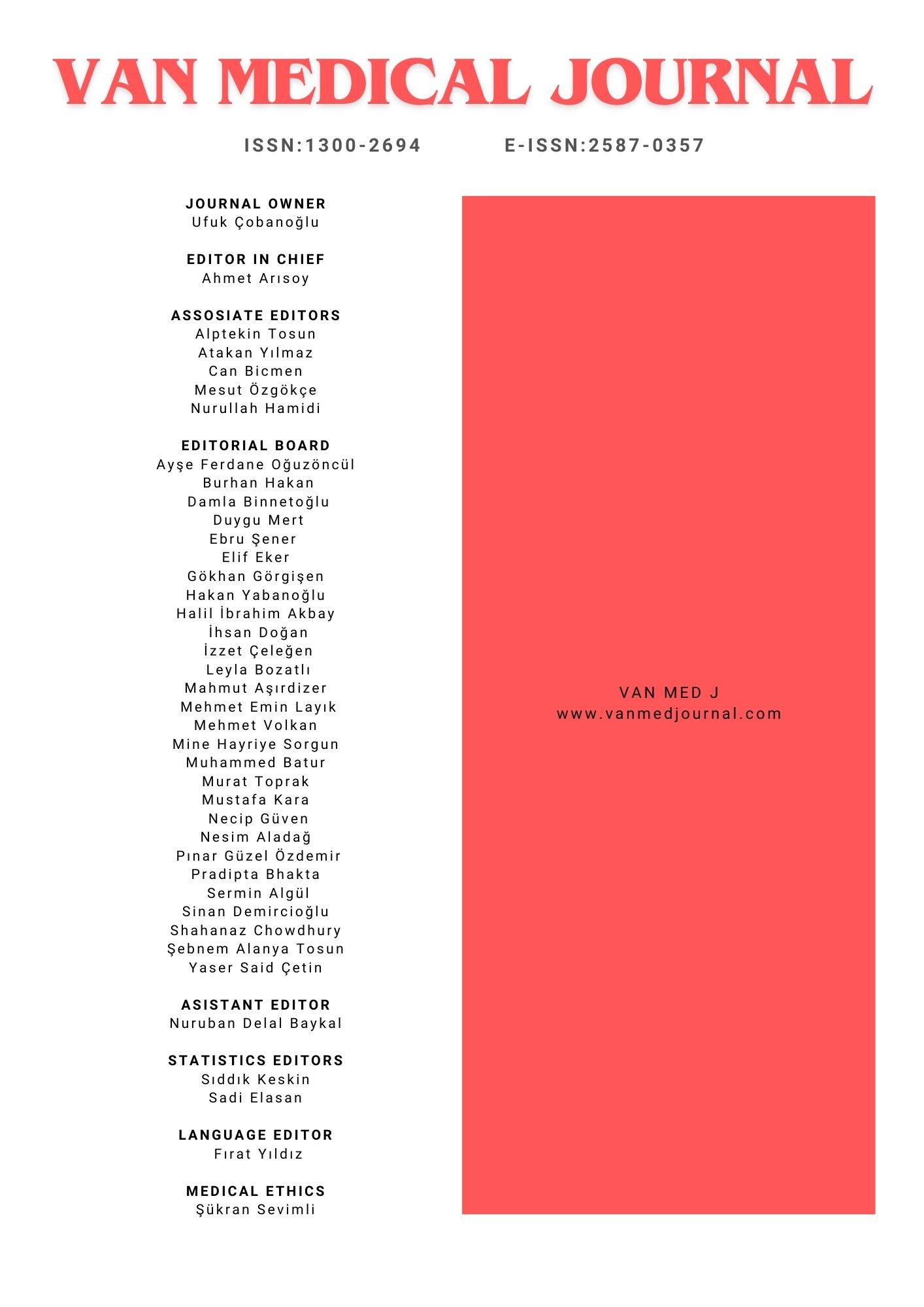The investigation of the causative agents with culture and fluorescence antibody methods in adult patients with community-acquired pneumonia
Hamza Bozkurt1, İhsan Hakkı Çiftçi2, Hüseyin Güdücüoğlu3, Bülent Özbay4, Şafak Andiç5, Mustafa Berktaş61Yüzüncü Yıl Üniversitesi, Tıp Fakültesi, Mikrobiyoloji Ana Bilim Dalı, VAN.2Kocatepe Üniversitesi, Tıp Fakültesi, Mikrobiyoloji Ana Bilim Dalı, AFYON.
3Yüzüncü Yıl Üniversitesi, Tıp Fakültesi, Mikrobiyoloji Ana Bilim Dalı, VAN.
4Yüzüncü Yıl Üniversitesi, Tıp Fakültesi, Göğüs Hastalıkları Ana Bilim Dalı, VAN
5Yüzüncü Yıl Üniversitesi, Tıp Fakültesi, Mikrobiyoloji Ana Bilim Dalı, VAN.
6Yüzüncü Yıl Üniversitesi, Tıp Fakültesi, Mikrobiyoloji Ana Bilim Dalı, VAN.
Aim: In this study was designed to investigate causative agents in patients with community-acquired pneumonia by use of culture and immunofluorescence antibodies. Methods: According to this purpose in 50 patients with clinically diagnosed pneumonia, blood cultures using BACTEC 9120 system (Beckton Dickinson - USA), sputum cultures with conventional methods were performed and isolated agents were identified with Sceptor panels (Becton Dickinson - USA). Also from the serums of the patients, using indirect fluorescence antibody methods (Pneumo Slide test-Poligono Industrial Dos De Octubre) IgM antibody against 9 pneumonia agents were investigated. Results: From a total of 50 patients the diagnosis was determined in 13 (26 %) with blood culture, in 6 (12 %) with sputum culture and in 26 (56 %) with indirect fluorescence antibody methods. In the end of the three study, rates of isolation of specific pathogens responsible for community-acquired pneumonia in our region were as follows: Streptococcus pneumoniae, 18 %, Legionella pneumophilia, 12 %, Mycoplasma pneumoniae 12 %, Influenza A 10 %, Haemophilus influenzae 8 %, Staphylococcus aureus 6 %, Adenovirus 6 %, Klebsiella pneumoniae 4 %, Parainfluenza 4 %, Respiratory syncytial virus 2 %, Influenza B 2 %, Coxiella burnetii 2 %, Chlamydia pneumoniae 2 %, Staphylococcus epidermis 2 %. With those methods couldn’t have been identified specific pathogen in 10 % of patients. Conclusion: In pneumoniae, which is an important health problem with high mortality and morbidity rates, it is necessary to diagnose with multiple methods for correct and early diagnosis of the disease.
Keywords: Pneumonia, indirect fluorescence antibody test, blood culture, sputum culture.Pnömoni Tanılı Erişkin Hastalarda Kültür ve Floresan Antikor Yöntemleriyle Etkenlerin Araştırılması
Hamza Bozkurt1, İhsan Hakkı Çiftçi2, Hüseyin Güdücüoğlu3, Bülent Özbay4, Şafak Andiç5, Mustafa Berktaş61Yüzüncü Yıl Üniversitesi, Tıp Fakültesi Mikrobiyoloji Anabilim Dalı, Van2Kocatepe Üniversitesi, Tıp Fakültesi, Mikrobiyoloji Ana Bilim Dalı, AFYON
3Yüzüncü Yıl Üniversitesi, Tıp Fakültesi, Tıbbi Mikrobiyoloji Anabilim Dalı, Van
4Yüzüncü Yıl Üniversitesi Tıp Fakültesi Göğüs Hastalıkları Anabilim Dalı, Van
5Yüzüncü Yıl Üniversitesi, Tıp Fakültesi, Mikrobiyoloji Ana Bilim Dalı, Van
6Yüzüncü Yıl Üniversitesi, Tıp Fakültesi, Tıbbi Mikrobiyoloji AD, Van
Amaç: Bu çalışmada, toplum kökenli pnömoni tanısı konulan hastalarda kültür ve indirekt floresan antikor yöntemi ile etkenlerin araştırılması amaçlanmıştır. Yöntem: Klinik olarak pnömoni tanısı konmuş 50 hastadanın klasik yöntemler kullanılarak balgam kültürleri yapılmış, Bactec 9120 sistemi ile kan kültürleri (Becton Dickinson- USA) alınmış, izole edilen etkenler Sceptor (Becton Dickinson- USA) panelleri ile identifıye edilmiştir. Ayrıca hastalardan alınan serum örneklerinde indirekt floresan antikor yöntemi (Pneumoslide test - Poligono Industrial Dos De Octubre) ile 9 pnömoni etkenine karşı IgM antikorları araştırılmıştır. Bulgular: Çalışma kapsamındaki 50 pnömonili hastanın 13 (% 26)’ünde kan kültürü, 6 (% 12)’sında balgam kültürü, 26 (% 52)’sında ise indirekt floresan antikor yöntemi ile tanı konulmuştur. Bu üç yöntemle yapılan çalışma sonucunda, bölgemizde erişkin yaş grubunda gözlenen toplum kökenli pnömoni vakalarının % 18’inde Streptococcus pneumoniae, % 12’sinde Legionella pneumophilia, % 12’sinde Mycoplasma pneumoniae, % 10’unda Influenza A, % 8’inde Haemophilus influenzae, % 6’sında Staphylococcus aureus ve Adenovirus, % 4’ünde Klebsiella pneumoniae ve Parainfluenza, % 2’sinde Respiratory syncytial virus, Influenza B, Coxiella burnetii, Chlamydia pneumoniae ve Staphylococcus epidermidis’in etken oldukları saptanmıştır. Hastaların % 10’unda ise bu yöntemlerle etken saptanamamıştır. Sonuç: Mortalitesi ve morbiditesi yüksek bir sağlık sorunu olan pnömonilerde, hastalığın doğru ve erken tanısı açısından birden fazla yöntemle tanıya gidilmesi önemlidir.
Anahtar Kelimeler: Pnömoni, indirek floresan antikor testi, kan kültürü, balgam kültürü.Manuscript Language: Turkish

